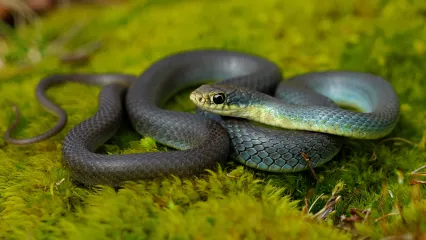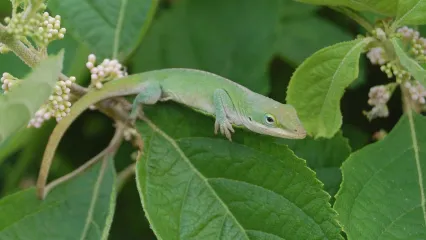
Description
The eastern racer can be distinguished from all other snakes in the region by a combination of smooth scales, cream to yellow belly with no marks, moderate size, and a divided anal scale. Background color of the body of adults is black in eastern Oklahoma. The eastern yellow-bellied racer can be found statewide except the Coastal Plain region of Oklahoma and the eastern quarter of the state. There are no stripes, cross bands, or blotches. Adults can be distinguished easily from other snakes in the area by keying in on the head and neck region. The top half will be black and the bottom half will be cream or white. Juveniles differ considerably from adults. The background color is gray and a series of irregular dark brown blotches extend from behind the head to the tail. Both adults and juveniles are nervous, active snakes and usually bite immediately when handled. The bite is harmless. Juveniles can be confused with coachwhip juveniles. The two species can be distinguished by differences in dorsal and ventral color patterns. Juvenile eastern racers have distinct regular blotches along the dorsal surface rather than irregular cross-markings. They also have a series of smaller blotches along the lateral surfaces of the body. The belly is usually yellow with rows of dark spots extending along most of the belly.
Size
Adults vary from about 24–48 inches but large females can reach nearly 70 inches. Hatchlings vary from about 8–12 inches in total length.
Habitat
In North America, the distribution of eastern racers extends north to south from southern Canada through Montana to southern Texas and west to east from western Montana in the north and central New Mexico to far western Missouri in the east. Other subspecies have distributions across the entire central, southern, and eastern United States.
Life Cycle
Eastern racers are active from March through October, depending on the local weather conditions. They are strictly diurnal. During spring and fall, they are active at mid-day whereas during summer they can be active during the entire day. Mating occurs from April to May and females deposit clutches of 8 to 29 eggs during June and July. Number of eggs produced by individual females is determined to a large extent by female size. Hatchings appear in late July, August, and early September. These snakes reach sexual maturity during their second year after losing the juvenile color pattern. Eastern racers eat a wide variety of prey. Juveniles feed on invertebrates including crickets and grasshoppers, but also take juvenile lizards. Adults feed mostly on vertebrates, including lizards, snakes, and their eggs. They probably also eat frogs, mice, and hatchlings of ground-nesting birds when they are available. Eastern racers are harmless to humans.
How To Observe
These are among the easiest snakes to find and observe, especially during spring. They are frequently seen on roads during morning or late afternoon and when approached, they “race” away. The only other snake that moves this rapidly is the coachwhip, which is much larger. Look in open areas, fields, or along edges of unpaved roads. Typically when these snakes “race” off, they crawl into the center of shrubs or under surface objects and seemingly disappear. If grabbed, eastern racers bite immediately. Their small teeth cause minimal bleeding and they are nonvenomous. Within a few minutes of handling, the snakes relax considerably and usually do not continue biting as long as they are handled gently.
(This profile was created by Dr. Laurie Vitt as part of a partnership between the Wildlife Department and the Sam Noble Oklahoma Museum of Natural History. It was funded as part of a larger State Wildlife Grant to survey and inventory amphibians and reptiles of the Wildlife Management Areas of Oklahoma: T-35-P-1.)

